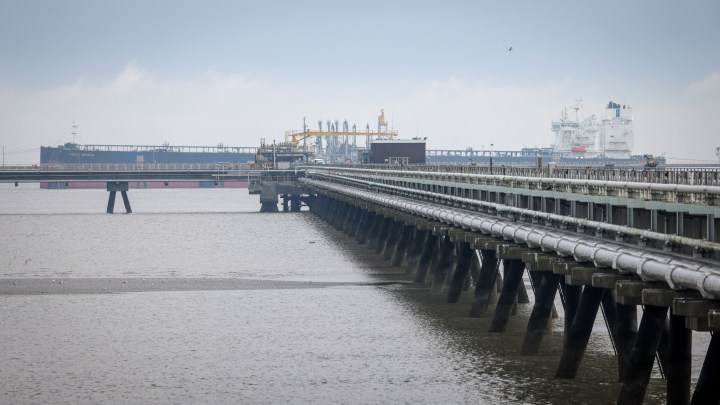
Europe would love to stockpile U.S. natural gas. Shipping bottlenecks stand in the way.
Europe would love to stockpile U.S. natural gas. Shipping bottlenecks stand in the way.

Europe’s natural gas problems have managed to get even worse.
First, Russia cut back on the amount of gas it was sending to the Continent. Then, it stopped deliveries through one pipeline altogether. Last week, four holes appeared in that pipeline, churning the waters above and spewing a massive amount of methane gas into the atmosphere.
That’s certainly not the kind of news Europeans want to hear, especially with winter approaching.
Pipelines aren’t the only way of delivering gas to places that lack their own supply. It’s also possible to move liquefied natural gas by tanker ship to Europe from, say, here in the U.S., where we have a lot of the stuff.
But it’s not just a matter of getting hold of some ships and filling ‘em up with liquid gas.
“An LNG carrier is very specific to carry methane, which has been reduced to its freezing point and turns to a liquid,” said Brad Williams, president of Spitfire Energy Advisors in Houston. “And the reason you do that is the volume decreases by 600 times.”
According to a (very) rough Marketplace estimate, one LNG tanker can carry enough gas for almost 50,000 U.S. homes for one year.
“There is limited numbers of LNG tankers globally,” said Anna Mikulska, a nonresident fellow at the Center for Energy Studies at Rice University’s Baker Institute for Public Policy. “So they are in general in short supply. And they will be highly valued, of course.”
About 700 LNG tankers are available for transport worldwide, and it takes about 2½ years to build a new one.
So, that’s the first bottleneck — but not the last.
“The main supply bottleneck is actually infrastructure,” said Matteo Ilardo, a European geopolitical analyst at the consultancy RANE. “Not necessarily shipping from producer to consumer, but actually the infrastructures for exporters to be able to liquefy the gas and ship it. And then the import infrastructures of buyers.”
In other words, there has to be infrastructure to cool the gas to get it onto a ship, and — at the other end — you need infrastructure to turn that liquid back into gas form.
There are only so many of those facilities in operation right now. And according to Williams, building a new one would likely cost energy companies quite a bit more than they may have planned for a few years ago.
“They’re realizing that the price quote they got to build their facility three years or even two years ago, as they refresh those engineering contracts, those prices have gone up 25%, 30%, 35%, depending on the facility,” he said.
Yet even if they can afford that, building these things takes time.
“Let’s say it takes six months to get the financing and 30 months to build the facility. You know, that’s a full three years before you actually receive any LNG,” Williams said. “And that’s predicated on lining up and getting the ships to deliver that LNG.”
Once they build them, investors expect the facility to make money for decades.
Some European countries are trying a cheaper solution for now. “Installing floating LNG terminals is a short, semi-short-term solution to increase import capacity,” Ilardo said.
Germany is slated to bring a few of those online by the end of this year, along with the Netherlands and Italy. Those will help accommodate Europe’s high demand for LNG now that Russia isn’t sending any gas, Illardo added. And that short-term gas infrastructure has another attractive quality.
“They can be decommissioned. There is no issue on investing in permanent structures that will remain there,” he said. “There is limited interest in that.”
Interest is limited because countries in Europe want to be done with fossil fuels before the end of an onshore terminal’s lifespan.
There’s a lot happening in the world. Through it all, Marketplace is here for you.
You rely on Marketplace to break down the world’s events and tell you how it affects you in a fact-based, approachable way. We rely on your financial support to keep making that possible.
Your donation today powers the independent journalism that you rely on. For just $5/month, you can help sustain Marketplace so we can keep reporting on the things that matter to you.

















